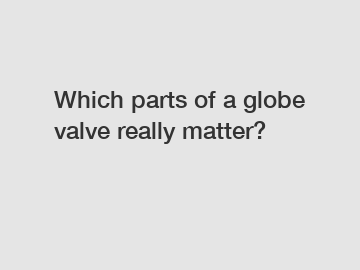Which parts of a globe valve really matter?
Which parts of a globe valve really matter?
Globe valves are an essential component in various industries, including oil and gas, energy, and manufacturing. These valves have a globe-shaped body and are designed to control the flow of liquids or gases by regulating the opening and closing of a movable disc or plug. When it comes to the functionality of a globe valve, several key parts play a crucial role. Let's take a closer look at these parts and understand their significance in the overall performance of a globe valve.
1. Body: The body of a globe valve serves as the main casing that encloses all the internal components. It is typically composed of durable materials such as cast iron, stainless steel, or bronze, depending on the application requirements. The body not only provides structural support but also acts as a barrier, preventing leakage and maintaining the integrity of the system.

2. Bonnet: The bonnet is the cover or cap that is attached to the top of the globe valve's body. Its primary function is to secure the valve stem and prevent any external elements from entering the valve assembly. Depending on the design, the bonnet may be bolted, screwed, or welded to the body. It is crucial to ensure a proper seal between the bonnet and the body to avoid any leakage.
3. Valve Stem: The valve stem connects the actuator (external control device) to the movable disc or plug inside the valve body. When the actuator rotates or moves the stem, it controls the position of the disc, consequently regulating the flow of fluid or gas. The stem must be strong and durable to withstand the forces exerted during operation and ensure precise control over the valve's opening and closing.
4. Disc or Plug: The disc or plug is the part that regulates the flow of media through the valve. It is attached to the valve stem and moves up and down or sideways to control the fluid or gas passage. The shape and design of the disc can vary, including flat-faced, tapered, or spherical, depending on the specific requirements of the application. The disc or plug material must be compatible with the media being handled to prevent corrosion or damage.
5. Seat: The seat is the interface where the disc or plug comes in contact with the valve body. It creates a tight seal, preventing any leakage or backflow when the valve is closed. The seat material must be resistant to wear, corrosion, and erosion, enabling the valve to maintain its tight shut-off capabilities throughout its service life. It is typically made of materials like stainless steel, bronze, or soft materials such as rubber or PTFE, depending on the application requirements.
6. Stem Packing: Stem packing is a critical part that ensures a tight seal between the valve stem and the bonnet. It prevents any leakage along the stem as it moves in and out of the valve body. Various types of packing materials, such as PTFE, graphite, or composite, are used to achieve an effective seal. Proper selection and maintenance of stem packing are essential to minimize any fugitive emissions and enhance the overall efficiency of the valve.
7. Actuator: While not a physical part of the valve itself, the actuator plays a vital role in operating the globe valve. Actuators can be manual, electric, pneumatic, or hydraulic, depending on the level of automation required. They convert external signals or energy into mechanical motion, allowing precise control over the valve's opening and closing. The choice of actuator depends on factors such as the valve's size, application requirements, and the available power source.
In conclusion, each part of a globe valve holds immense importance in ensuring its smooth and efficient operation. From the body to the disc, seat, stem, packing, and the actuator, each component plays a crucial role in controlling the flow of fluids or gases. Understanding and carefully selecting these parts based on the specific application requirements is essential for optimal valve performance, longevity, and safety. So, the next time you ponder over the significance of a globe valve, remember that all its parts matter in maintaining a reliable and effective flow control system.
Want more information on China marine cast steel valves manufacturer, China marine butterfly valves supplier, marine valves manufacturers? Feel free to contact us.
222
0
0

Comments
All Comments (0)